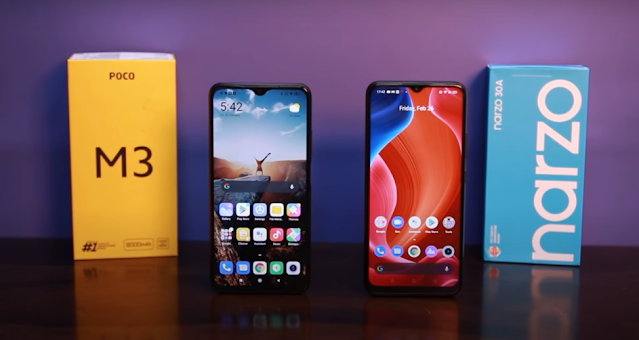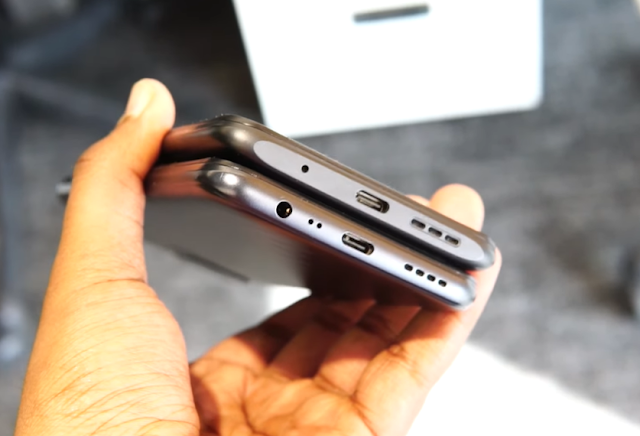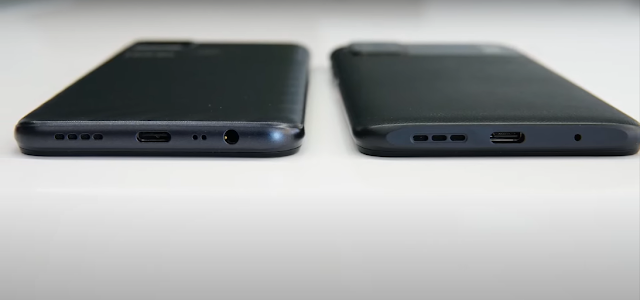Which is the better budget pick? Realme Narzo 30A or POCO M3
POCO and Narzo have been quite some time in the market as both are sub-brands of their parent companies. POCO, once a sub-brand of Xiaomi is now an independent company but still, it uses the custom skin MIUI which is seen on many Xiaomi smartphones whereas the Narzo series is a full-fledged series that is a part of Realme which focuses on budget smartphones with great performance.
The Realme Narzo 30 series has been launched this year that includes the Realme Narzo 30A and the Realme Narzo 30 Pro 5G (Review) whereas the company is yet to launch the Realme Narzo 30. The Realme Narzo 20 series had impressed many of the customers with some exciting specifications and we do expect this from this year’s Realme Narzo 30 series.
The Realme Narzo 30 Pro 5G is an impressive mid-range smartphone and the Realme Narzo 30A also gets some of the good specifications that will cater to the budget smartphone market. POCO M3 (Review) seems to be winning hearts with the specifications it has that include an attractive design, a full HD display, a 48MP camera, ships with 6GB RAM instead of 4GB as seen on other smartphones and has a lot going for it.
Can the Realme Narzo 30A take on the budget king of smartphones, the POCO M3 or will POCO M3 continue to be the best budget offering in the market? Let’s find out in the full comparison.
POCO M3 vs Realme Narzo 30A Design:
In terms of design, both the POCO M3 and the Realme Narzo 30A have a polycarbonate back but the materials used on both are slightly different. The POCO M3 has a polycarbonate back that has a leather finish with a textured back which is much better compared to a dual pattern on the Narzo 30A which has the upper half having a plainer look and the lower half with a diagonal pattern looks which seems like an extra add on.
The biggest difference between the two is the camera module on the back of both smartphones. The POCO M3 has a larger rectangular glossy glass layout which is black in color and houses a triple camera setup with a LED flash whereas the Narzo 30A has a square module that houses a dual-camera setup with a LED flash. The POCO M3 looks premium and is easier to hold.
On the front, both get a dew-drop notch with minimum bezels to the sides and slightly thicker at the bottom. To the sides, both get the power button with the volume buttons on the right, and at the bottom, both have a USB Type-C port, a primary microphone, and a loudspeaker grille. Both also have a dual SIM card slot with a dedicated microSD card slot for storage expansion to the left.
The Realme Narzo 30A gets a secondary noise-canceling microphone with the 3.5mm headphone jack at the bottom whereas the POCO M3 has both of them on the top. The POCO M3 also gets an additional speaker and an IR Blaster whereas the top of the Narzo 30A looks cleaner. Since these are budget smartphones, the build is not so premium as we have seen on glass backs.
The POCO M3 gets a P2i coating at the back whereas Realme has not mentioned which kind of protection is present on the Narzo 30A. Both have huge 6000mAh batteries, but POCO M3 is lighter at 193 grams compared to 205 grams on the Narzo 30A. So in terms of build quality and design, the POCO M3 is better compared to the Narzo 30A.
POCO M3 vs Realme Narzo 30A Display:
The display is where there is a slight difference on both smartphones. The POCO M3 has a slightly larger display at 6.53 inches compared to 6.5 inches on the Realme Narzo 30A. Both have an IPS LCD display with a standard 60Hz display. The difference lies in the resolution where the Realme Narzo 30A has an HD +(720×1600 pixels) display whereas POCO has gone for a Full HD+ (1080×2340 pixels) display.
The color reproduction on both is not the best when compared to a mid-range smartphone but still, they are great on their own. POCO M3 has a warmer tone whereas the Realme Narzo 30A has a cooler tone. The presence of a Full HD+ display on the POCO M3 means better screen legibility under direct sunlight and in dark also. The colors also pop out well on the POCO M3.
In terms of brightness, both displays are bright but here the Narzo 30A can go as high as 470nits compared to POCO M3’s 400nits. The Realme Narzo 30A does not have support for Widevine L1 and HDR both of which are present on the POCO M3 which means streaming HD videos from OTT platforms on POCO M3 is bliss.
The POCO M3 has Corning Gorilla Glass 3 for protection compared to Asahi Glass protection on the Realme Narzo 30A and the POCO M3 has a fingerprint scanner that is embedded into the power button whereas the Realme Narzo 30A has a physical touch-capacitive rear-mounted fingerprint scanner. The face unlock is also faster on the POCO M3 compared to the Realme Narzo 30A.
Overall, with a better display and support for Widevine L1 and HDR, the POCO M3 makes up for a great multimedia experience and has the better display of the two.
POCO M3 vs Realme Narzo 30A Performance:
In terms of performance, both the POCO M3 and the Realme Narzo 30A differ in terms of chipsets and storage options. The POCO M3 has the Snapdragon 662 which we saw on many smartphones like the
Moto G9 Power (Review),
Redmi 9 Power (Review), etc. whereas the Realme Narzo 30A gets the Mediatek Helio G85 chipset.
The Mediatek Helio G85 is a great chipset for budget smartphones as it is an octa-core chipset that packs 2×2.0 GHz Cortex A75 cores and another 6×1.8 GHz Cortex-A55 cores with a Mali-G52 MC2 GPU whereas the POCO M3 has a Snapdragon 662 which is also an octa-core chipset that has 2×2.0 GHz Kryo 260 Gold cores and another 6×1.8 GHz Kryo 260 Silver cores coupled with Adreno 610 GPU.
Both seem to handle everything with ease whether it is switching between applications, scrolling through webpages, or watching videos on a daily basis. However, with the POCO M3, we did see some minor stutters which was not the case with the Realme Narzo 30A though the chipset is pushing only a 720p display.
All heavy games like Call Of Duty, Asphalt 9 Extreme ran smoothly on each smartphone at the medium graphics settings. The Realme Narzo 30A is only restricted to Medium graphics whereas, on the POCO M3, the graphics can be set to very high which means the POCO M3 can play high-end games with ease. However, there is a different story.
The Mediatek Helio G85 provides better gameplay compared to the Snapdragon 662 and though the Realme Narzo 30A has a 720p display, we did not notice any frame drops at the Medium settings whereas on the POCO M3, there was some frame drops noticed but the touch response on the POCO M3 was better.
In terms of storage, the Realme Narzo 30A has two variants: 3GB RAM and 32GB storage and another 4GB RAM and 64GB storage where storage speeds are eMMC 5.1 whereas the POCO M3 ships with a base 6GB RAM which was never seen on a budget smartphone so it has two variants: 6GB RAM and 64GB storage and another 6GB RAM and 128GB storage where storage speeds are UFS 2.1 and UFS 2.2.
And for further storage, both get an additional slot for a microSD card. The RAM management was also slightly better on the POCO M3 compared to the Realme Narzo 30A. In terms of benchmarks, the Realme Narzo 30A scores 203032 in Antutu v8 compared to 179388 on the POCO M3.
In Geekbench 5.1, the Realme Narzo 30A scores better on the single-core score of 354 compared to 317 on the POCO M3, and in terms of multi-core scores, the POCO M3 scores 1336 which is slightly higher than 1276 on the Realme Narzo 30A.
Technically, there is not much of a difference in day-to-day performance but still, with faster storage speeds, higher RAM variants, and better graphics, the POCO M3 is the better one compared to the Realme Narzo 30A.
POCO M3 vs Realme Narzo 30A Software:
The Realme Narzo 30A runs on RealmeUI 1.0 based on Android 10 out of the box compared to POCO M3 which runs on a POCO launcher with MIUI 12 and has Android 10. Both will be soon updated to Android 11. The software experience is equally good on both and multi-tasking is good on each of these.
The POCO M3 has a POCO launcher which means there are no more ads present in the user interface but still like many Redmi smartphones, there is a whole lot of bloatware present which makes the user interface cumbersome to use. The RealmeUI, on the other hand, has bloatware but it provides a cleaner and smoother software experience almost close to Stock Android.
The RealmeUI comes with a lot of features like a smart sidebar, super nighttime standby under Realme labs and provides many customizations to the icons. On the other hand, MIUI is not far behind as it gets all the basic features like a system-wide dark mode, navigation gestures, and some Mi-specific applications just like Realme has its own set of applications.
Though the Realme Narzo 30A has an HD panel, there are no stutters noticed something which was slightly present on the POCO M3. Overall, with the better RealmeUI, the Realme Narzo 30A provides a better software experience overall.
POCO M3 vs Realme Narzo 30A Cameras:
The POCO M3 comes with a triple camera setup that includes a 48MP main camera, a 2MP macro camera, and a 2MP depth camera. The Realme Narzo 30A, on the other hand, has a 13MP main camera and a 2MP depth camera only. It misses out on a macro camera and both lack an ultrawide camera which is present on the Redmi 9 Power only in the budget segment.
Comparing images from the main camera on both, the color reproduction is good on both smartphones but the POCO M3 has a more natural look whereas the colors look saturated on the Realme Narzo 30A and there is some overexposure noticed. The dynamic range is better on the POCO M3 as it captures many detailed images compared to the Realme Narzo 30A.
However, the camera performance is not so good considering these are budget smartphones. The Realme Narzo 30A has lesser noise and better white balance though. The difference is minimal but here POCO M3’s 48MP camera outperforms the 13MP camera on the Realme Narzo 30A. With HDR turned on, the images from the Realme Narzo 30A look better with good color saturation though.
With HDR on
With HDR on
The macro images from the POCO M3 are just as an extra which results in close-up images with loss in details and the colors also look washed out. Both can use the main camera to get a good close-up image but it does apply a lot of crops and here also due to the larger 48MP camera, the POCO M3 takes better macro images with details compared to the Realme Narzo 30A.
In terms of portraits, the POCO M3 images have better edge detection and the dynamic range is also good overall. The skin colors look much more natural on the POCO M3 whereas there is some bluish tint noticed on the portraits shot on the Realme Narzo 30A. The edge detection is equally good on both but the level of background blur is better on the POCO M3 compared to the Realme Narzo 30A.
At night, the main camera on the POCO M3 does a great job in terms of dynamic range and the color reproduction is also better compared to the Realme Narzo 30A. The images on the Realme Narzo 30A have more noise and there is a lot of overexposure.
Turning on the dedicated Night Mode on both, here the Realme Narzo 30A outshines the POCO M3 where it has better dynamic range and the color saturation is much better compared to the POCO M3. The POCO M3 with the dedicated Night Mode results in inconsistent colors and the dynamic range takes a hit here.
On the front, both have an 8MP camera and here the Realme Narzo 30A has more details and better color saturation compared to the POCO M3. The selfies taken from the Realme Narzo 30A have better dynamic range and when you zoom into the selfies, the details on the POCO M3 look softer. The POCO M3 has a slight yellowish tint in the selfies.
The selfie portraits also continue to please on the Realme Narzo 30A with better color saturation and dynamic range. The edge detection is good on both but when it comes to background blur, the POCO M3 is better compared to the Realme Narzo 30A. Though the Realme Narzo 30A has lower noise.
In terms of videos, both the POCO M3 and the Realme Narzo 30A can shoot 1080p videos at 30fps. The videos from the POCO M3 have better color reproduction and dynamic range compared to the Realme Narzo 30A. The POCO M3 has lesser noise and slightly better stabilization also. The Realme Narzo 30A videos have inconsistent colors and the camera cannot lock focus onto a subject properly.
On the front, the videos come out better on the Realme Narzo 30A in terms of dynamic range and color saturation with more natural-looking skin tones, and also the noise is lower compared to the POCO M3. Portrait videos on the rear camera were better on the POCO M3 and on the front, the Realme Narzo 30A is better.
Overall, in terms of camera, the POCO M3 has the better set of rear cameras whereas, on the front, the Realme Narzo 30A is the better one.
POCO M3 vs Realme Narzo 30A Battery Life:
Both the POCO M3 and the Realme Narzo 30A have larger 6000mAh batteries and can easily last for two days continuously with normal usage. Since both lack a high refresh rate display, the battery can easily last, and with heavy usage that includes gaming Call Of Duty, streaming videos for 3-4 hours, and also scrolling through webpages, the Realme Narzo 30A was slightly better.
In many of the battery tests, the battery drain was marginally lower on the Realme Narzo 30A as the display is just HD instead of Full HD+ on the POCO M3. The standard screen-on time on both smartphones was around 7-8 hours but on the Realme Narzo 30A. The battery optimizations are better on the MIUI though.
In terms of charging, both the smartphones ship with an 18W fast charger included inside the box. The Realme Narzo 30A takes 3 hours and 30 minutes which is 30 minutes more than the POCO M3 which takes 3 hours. Still, 3 hours is much more but since these are budget smartphones, there is no point in any complaint.
So battery life, the Realme Narzo 30A is better but in terms of charging, the POCO M3 is faster.
POCO M3 vs Realme Narzo 30A Audio Quality:
Here clearly, the POCO M3 is better compared to the Realme Narzo 30A as it has a stereo speaker setup as it has speakers both on the top as well as the bottom compared to just a single speaker on the Realme Narzo 30A. The sound quality is much better on the POCO M3 and even at the loudest sound setting, the POCO M3 is much better compared to the Realme Narzo 30A.
Both have a 3.5mm headphone jack and here the sound output is better on the POCO M3 compared to the Realme Narzo 30A. Overall, the audio quality is good on the POCO M3.
Verdict:
Overall, if you see both the POCO M3 and the Realme Narzo 30A are very capable budget smartphones. The POCO M3 is a great smartphone which is having some segment first features like a Full HD+ display, stereo speakers and ships with 6GB RAM in the base variant. When you compare with the competition, it does stand out from the rest.
The POCO M3 has an attractive and unique design when compared to the Realme Narzo 30A with that glass back around the camera module and it also has a better display, better audio quality, provides an ad-free software experience and also has the better set of rear cameras. It also has better configuration and faster storage speeds of UFS 2.2.
The Realme Narzo 30A on the other hand, has better front camera and the gaming experience is slightly better compared to the POCO M3. And if you want a Stock Android like user experience, then the Realme Narzo 30A is the clear one to choose. But considering all other factors whether it is the display, processor, design, cameras and audio quality, the POCO M3 is the better option and is the better of the two.























